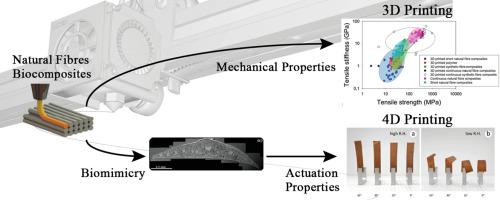当前位置:
X-MOL 学术
›
Mater. Des.
›
论文详情
Our official English website, www.x-mol.net, welcomes your
feedback! (Note: you will need to create a separate account there.)
A review of 3D and 4D printing of natural fibre biocomposites
Materials & Design ( IF 7.6 ) Pub Date : 2020-09-01 , DOI: 10.1016/j.matdes.2020.108911 Antoine Le Duigou , David Correa , Masahito Ueda , Ryosuke Matsuzaki , Mickael Castro
Materials & Design ( IF 7.6 ) Pub Date : 2020-09-01 , DOI: 10.1016/j.matdes.2020.108911 Antoine Le Duigou , David Correa , Masahito Ueda , Ryosuke Matsuzaki , Mickael Castro

|
Abstract To date, the literature has focused on synthetic fibre-reinforced composites, but it has not adequately addressed the unique properties that differentiate natural from synthetic fibres, such as their natural variation in microstructure and composition across species. This review paper proposes a critical overview of the current state of 3D printing of natural fibre-reinforced composites or biocomposites for mechanical purposes, as well as an overview of their role in 4D printing for stimuli-responsive applications. The paper is structured as follows: after the first part recalling the specificities of natural fibres and their associated composites, the two main sections are each divided into two parts presenting an analysis of the available data to provide fundamental understandings and a discussion and outlook for the future. Natural discontinuous fibre-reinforced polymers exhibit moderate mechanical properties compared to composites manufactured by conventional processes due to specific factors of the 3D printing process, such as high porosity, low fibre content, and a very low fibre-aspect ratio (L/d). Hygromorph BioComposites (HBC) are categorized into a new class of smart materials that could be used for 4D printing of shape-changing mechanisms. Fibre content, fibre orientation control, and fibre continuity are outlined in relation to known challenges in actuation performance.
中文翻译:

天然纤维生物复合材料的 3D 和 4D 打印综述
摘要 迄今为止,文献主要关注合成纤维增强复合材料,但尚未充分解决区分天然纤维与合成纤维的独特性质,例如它们在微观结构和成分之间的自然变化。这篇综述论文对用于机械目的的天然纤维增强复合材料或生物复合材料的 3D 打印现状进行了重要概述,并概述了它们在刺激响应应用的 4D 打印中的作用。该论文的结构如下:在第一部分回顾天然纤维及其相关复合材料的特性之后,两个主要部分分别分为两部分,分别对可用数据进行分析,以提供基本的理解以及讨论和展望未来。由于 3D 打印工艺的特定因素,例如高孔隙率、低纤维含量和非常低的纤维纵横比 (L/d),与通过传统工艺制造的复合材料相比,天然不连续纤维增强聚合物表现出中等的机械性能。Hygromorph 生物复合材料 (HBC) 被归类为一类新的智能材料,可用于变形机制的 4D 打印。纤维含量、纤维取向控制和纤维连续性与驱动性能方面的已知挑战有关。Hygromorph 生物复合材料 (HBC) 被归类为一类新的智能材料,可用于变形机制的 4D 打印。纤维含量、纤维取向控制和纤维连续性与驱动性能方面的已知挑战有关。Hygromorph 生物复合材料 (HBC) 被归类为一类新的智能材料,可用于变形机制的 4D 打印。纤维含量、纤维取向控制和纤维连续性与驱动性能方面的已知挑战有关。
更新日期:2020-09-01
中文翻译:

天然纤维生物复合材料的 3D 和 4D 打印综述
摘要 迄今为止,文献主要关注合成纤维增强复合材料,但尚未充分解决区分天然纤维与合成纤维的独特性质,例如它们在微观结构和成分之间的自然变化。这篇综述论文对用于机械目的的天然纤维增强复合材料或生物复合材料的 3D 打印现状进行了重要概述,并概述了它们在刺激响应应用的 4D 打印中的作用。该论文的结构如下:在第一部分回顾天然纤维及其相关复合材料的特性之后,两个主要部分分别分为两部分,分别对可用数据进行分析,以提供基本的理解以及讨论和展望未来。由于 3D 打印工艺的特定因素,例如高孔隙率、低纤维含量和非常低的纤维纵横比 (L/d),与通过传统工艺制造的复合材料相比,天然不连续纤维增强聚合物表现出中等的机械性能。Hygromorph 生物复合材料 (HBC) 被归类为一类新的智能材料,可用于变形机制的 4D 打印。纤维含量、纤维取向控制和纤维连续性与驱动性能方面的已知挑战有关。Hygromorph 生物复合材料 (HBC) 被归类为一类新的智能材料,可用于变形机制的 4D 打印。纤维含量、纤维取向控制和纤维连续性与驱动性能方面的已知挑战有关。Hygromorph 生物复合材料 (HBC) 被归类为一类新的智能材料,可用于变形机制的 4D 打印。纤维含量、纤维取向控制和纤维连续性与驱动性能方面的已知挑战有关。











































 京公网安备 11010802027423号
京公网安备 11010802027423号